Data Analytics Report
VerifiedAdded on 2019/11/08
|11
|1096
|142
Report
AI Summary
This data analytics report presents a comprehensive analysis of startup costs for five different business types (pizza, baker/donuts, shoe stores, gift stores, and pet stores) and a regression analysis of net annual sales. Descriptive statistics (mean, median, mode, range, variance, standard deviation) are calculated and presented for each business type, along with frequency and relative frequency distributions and histograms. An ANOVA test is conducted to determine if there's a significant difference in startup costs between the business types. The report then moves to a regression analysis, modeling net annual sales based on factors like square footage, inventory, advertising spend, sales district size, and number of competitors. The model's goodness of fit (R-squared) is assessed, and ANOVA is used to test the significance of the overall model. Individual variable significance is evaluated, and confidence intervals for slope coefficients are provided. Finally, the report demonstrates how to use the regression equation to predict annual sales for a specific franchisee scenario.
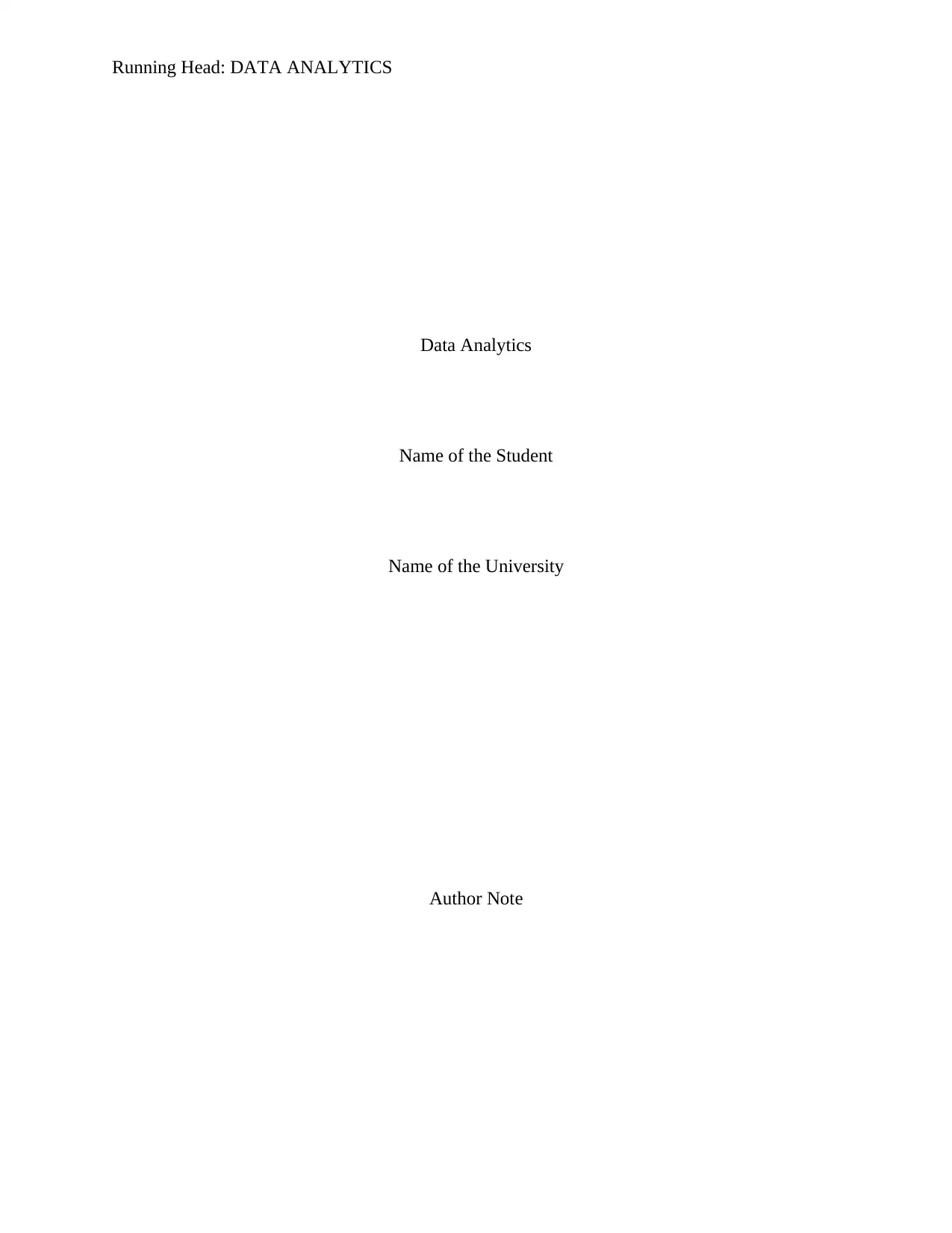
Running Head: DATA ANALYTICS
Data Analytics
Name of the Student
Name of the University
Author Note
Data Analytics
Name of the Student
Name of the University
Author Note
Paraphrase This Document
Need a fresh take? Get an instant paraphrase of this document with our AI Paraphraser
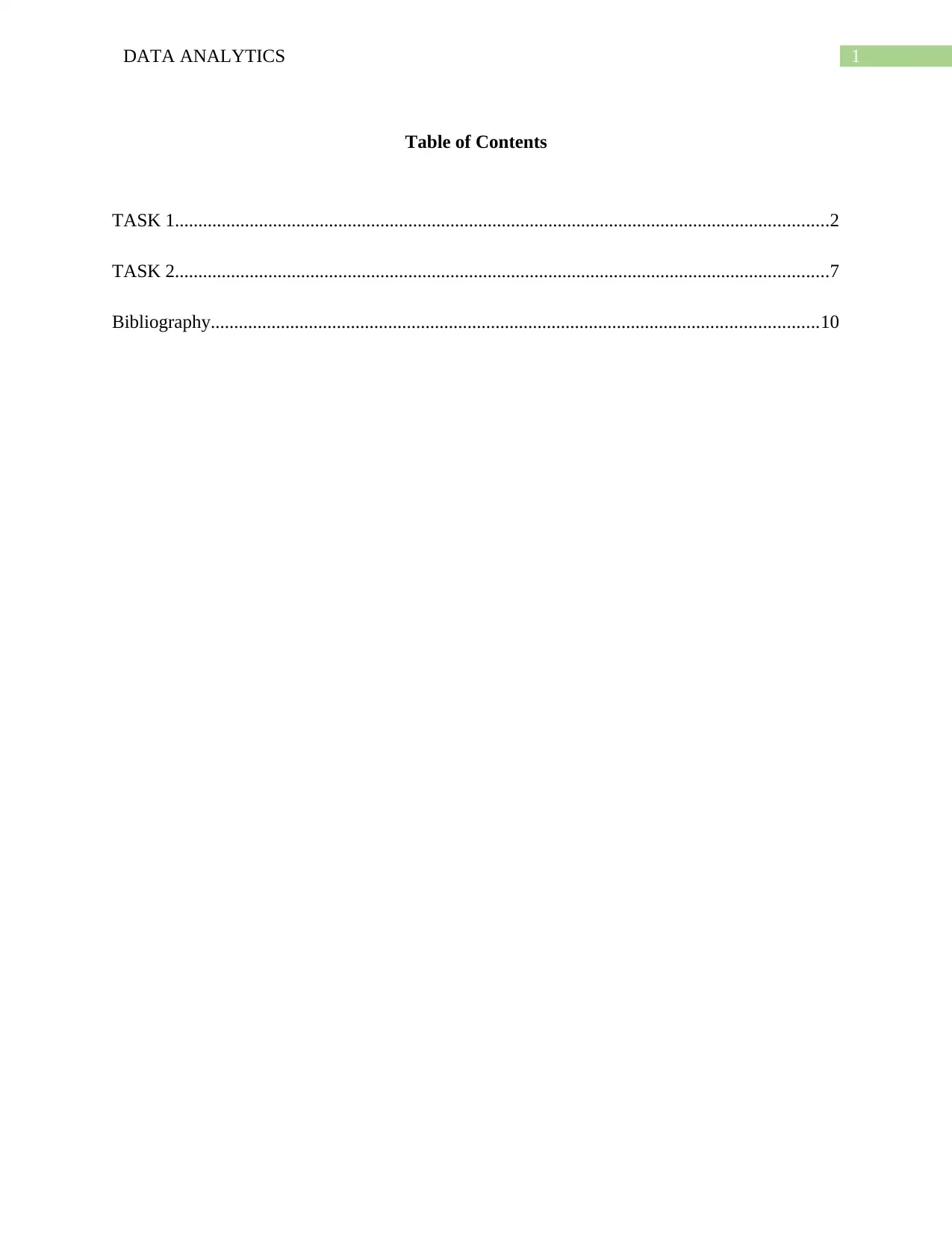
1DATA ANALYTICS
Table of Contents
TASK 1............................................................................................................................................2
TASK 2............................................................................................................................................7
Bibliography..................................................................................................................................10
Table of Contents
TASK 1............................................................................................................................................2
TASK 2............................................................................................................................................7
Bibliography..................................................................................................................................10
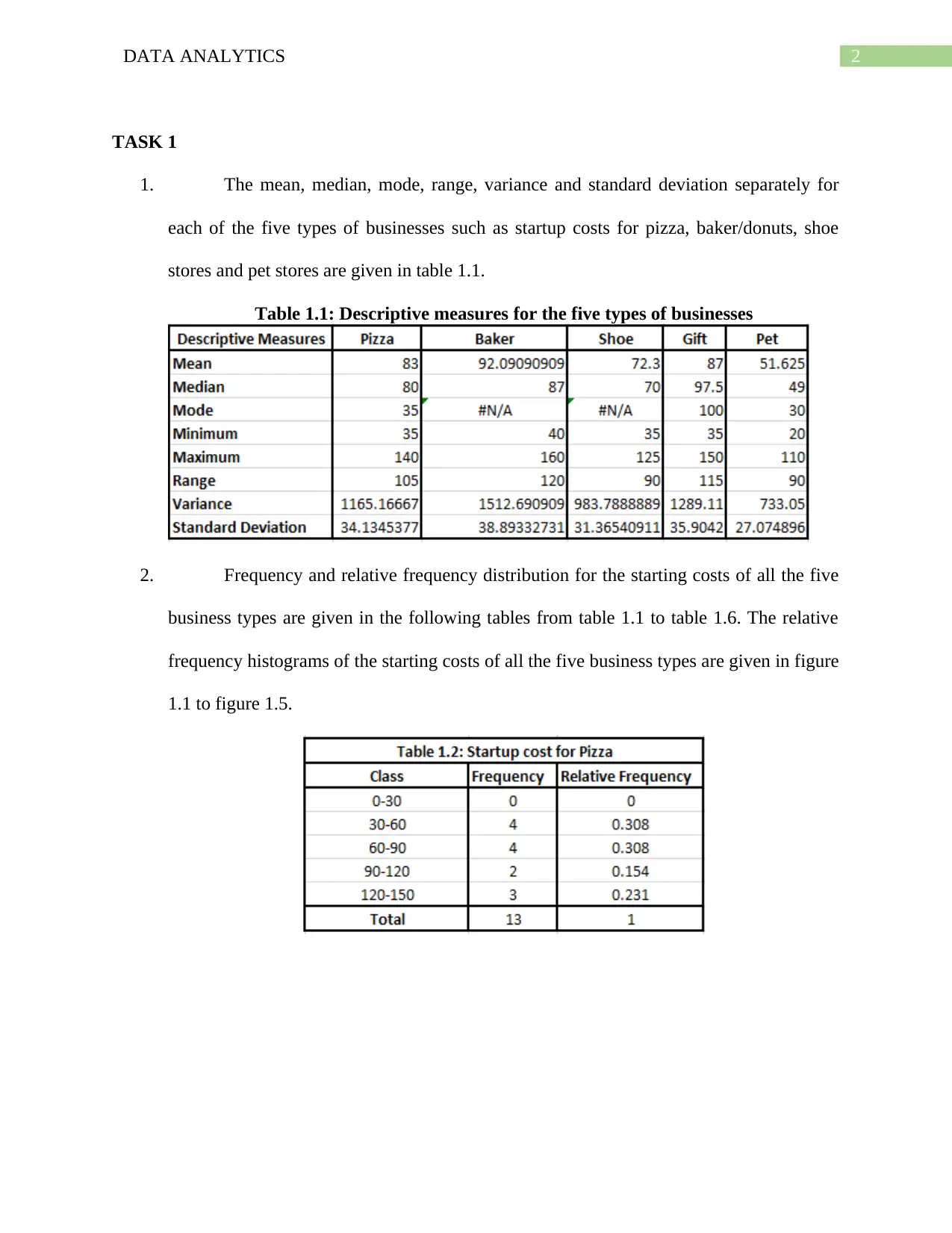
2DATA ANALYTICS
TASK 1
1. The mean, median, mode, range, variance and standard deviation separately for
each of the five types of businesses such as startup costs for pizza, baker/donuts, shoe
stores and pet stores are given in table 1.1.
Table 1.1: Descriptive measures for the five types of businesses
2. Frequency and relative frequency distribution for the starting costs of all the five
business types are given in the following tables from table 1.1 to table 1.6. The relative
frequency histograms of the starting costs of all the five business types are given in figure
1.1 to figure 1.5.
TASK 1
1. The mean, median, mode, range, variance and standard deviation separately for
each of the five types of businesses such as startup costs for pizza, baker/donuts, shoe
stores and pet stores are given in table 1.1.
Table 1.1: Descriptive measures for the five types of businesses
2. Frequency and relative frequency distribution for the starting costs of all the five
business types are given in the following tables from table 1.1 to table 1.6. The relative
frequency histograms of the starting costs of all the five business types are given in figure
1.1 to figure 1.5.
⊘ This is a preview!⊘
Do you want full access?
Subscribe today to unlock all pages.

Trusted by 1+ million students worldwide
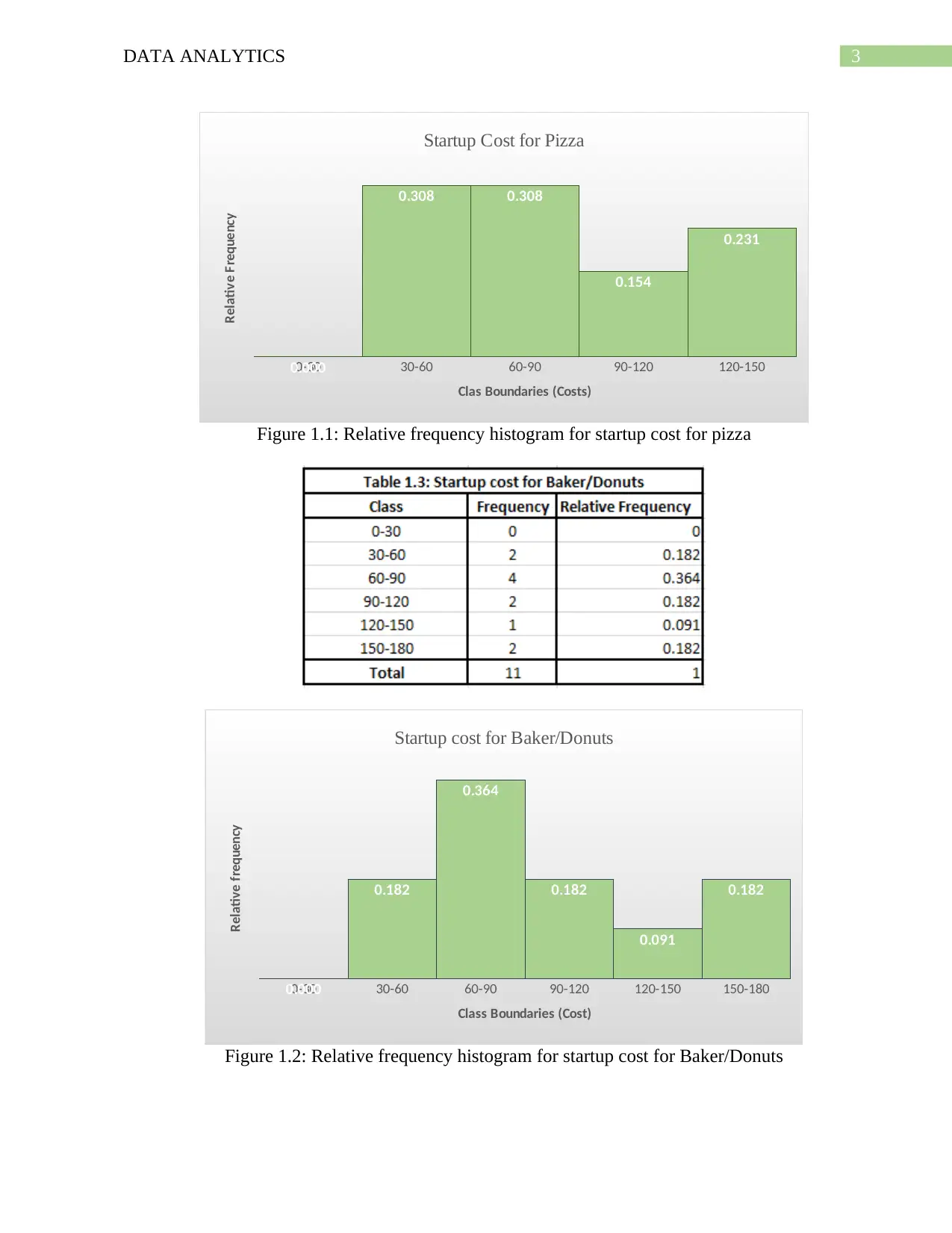
3DATA ANALYTICS
0-30 30-60 60-90 90-120 120-1500.000
0.308 0.308
0.154
0.231
Startup Cost for Pizza
Clas Boundaries (Costs)
Relative Frequency
Figure 1.1: Relative frequency histogram for startup cost for pizza
0-30 30-60 60-90 90-120 120-150 150-1800.000
0.182
0.364
0.182
0.091
0.182
Startup cost for Baker/Donuts
Class Boundaries (Cost)
Relative frequency
Figure 1.2: Relative frequency histogram for startup cost for Baker/Donuts
0-30 30-60 60-90 90-120 120-1500.000
0.308 0.308
0.154
0.231
Startup Cost for Pizza
Clas Boundaries (Costs)
Relative Frequency
Figure 1.1: Relative frequency histogram for startup cost for pizza
0-30 30-60 60-90 90-120 120-150 150-1800.000
0.182
0.364
0.182
0.091
0.182
Startup cost for Baker/Donuts
Class Boundaries (Cost)
Relative frequency
Figure 1.2: Relative frequency histogram for startup cost for Baker/Donuts
Paraphrase This Document
Need a fresh take? Get an instant paraphrase of this document with our AI Paraphraser
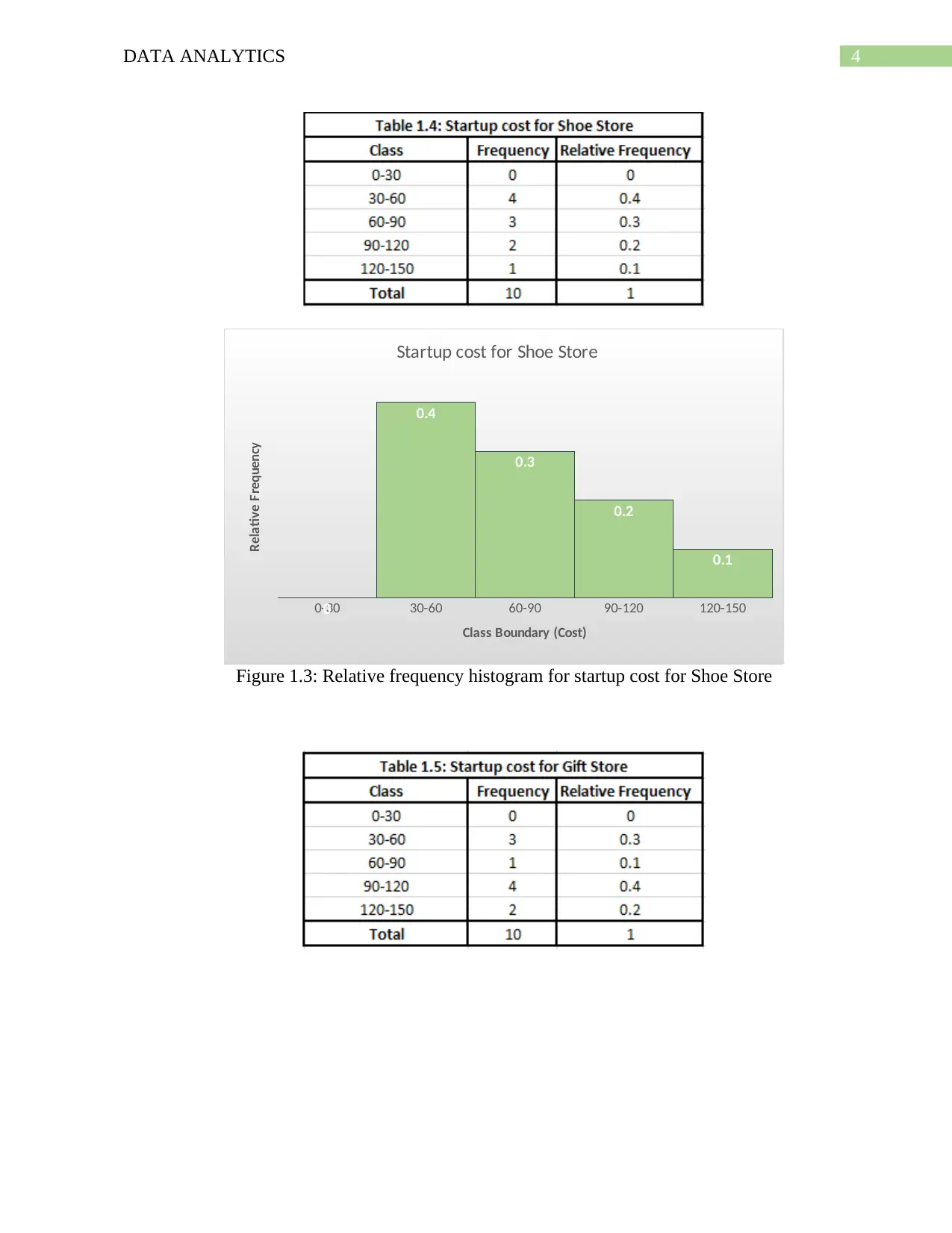
4DATA ANALYTICS
0-30 30-60 60-90 90-120 120-1500
0.4
0.3
0.2
0.1
Startup cost for Shoe Store
Class Boundary (Cost)
Relative Frequency
Figure 1.3: Relative frequency histogram for startup cost for Shoe Store
0-30 30-60 60-90 90-120 120-1500
0.4
0.3
0.2
0.1
Startup cost for Shoe Store
Class Boundary (Cost)
Relative Frequency
Figure 1.3: Relative frequency histogram for startup cost for Shoe Store
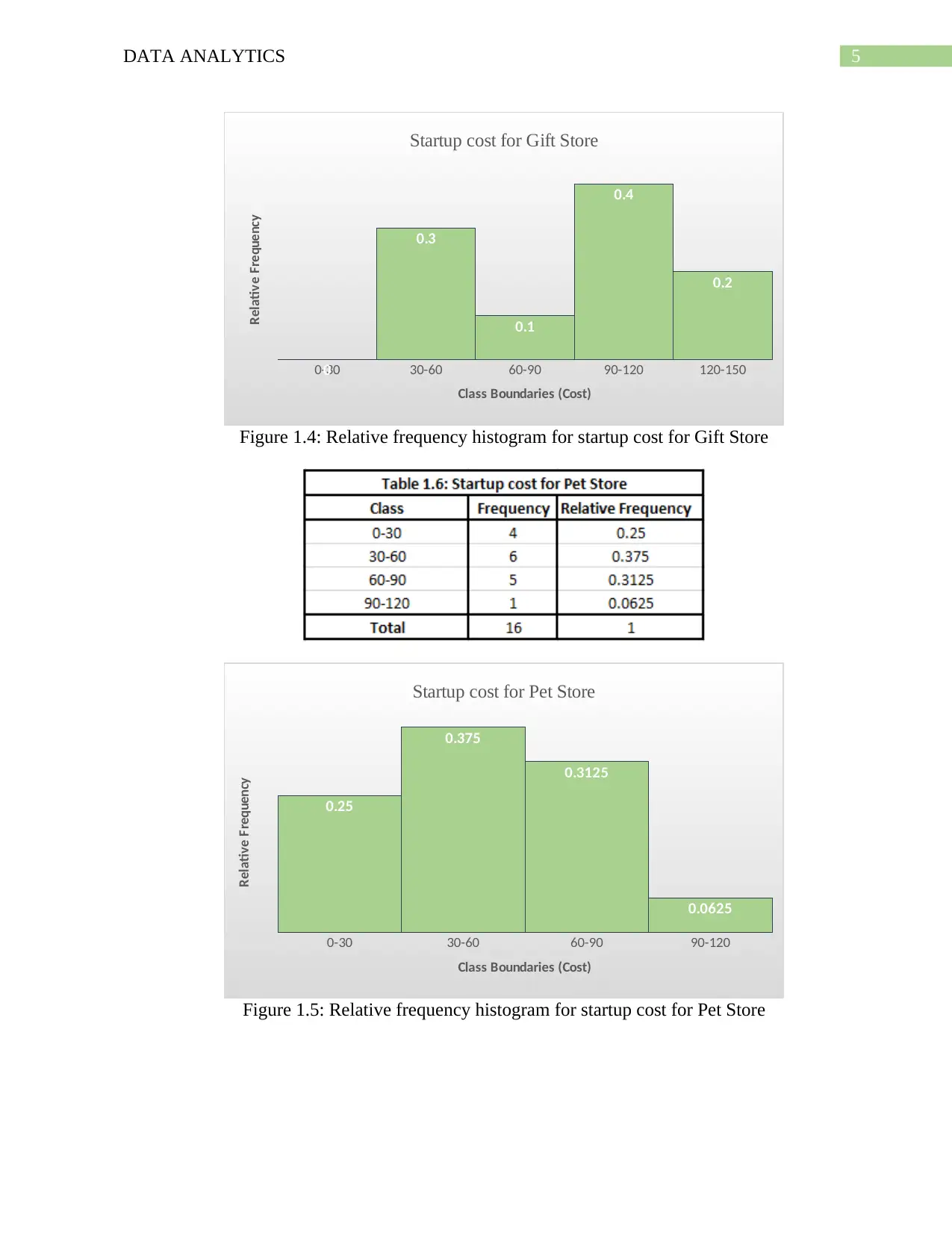
5DATA ANALYTICS
0-30 30-60 60-90 90-120 120-1500
0.3
0.1
0.4
0.2
Startup cost for Gift Store
Class Boundaries (Cost)
Relative Frequency
Figure 1.4: Relative frequency histogram for startup cost for Gift Store
0-30 30-60 60-90 90-120
0.25
0.375
0.3125
0.0625
Startup cost for Pet Store
Class Boundaries (Cost)
Relative Frequency
Figure 1.5: Relative frequency histogram for startup cost for Pet Store
0-30 30-60 60-90 90-120 120-1500
0.3
0.1
0.4
0.2
Startup cost for Gift Store
Class Boundaries (Cost)
Relative Frequency
Figure 1.4: Relative frequency histogram for startup cost for Gift Store
0-30 30-60 60-90 90-120
0.25
0.375
0.3125
0.0625
Startup cost for Pet Store
Class Boundaries (Cost)
Relative Frequency
Figure 1.5: Relative frequency histogram for startup cost for Pet Store
⊘ This is a preview!⊘
Do you want full access?
Subscribe today to unlock all pages.

Trusted by 1+ million students worldwide
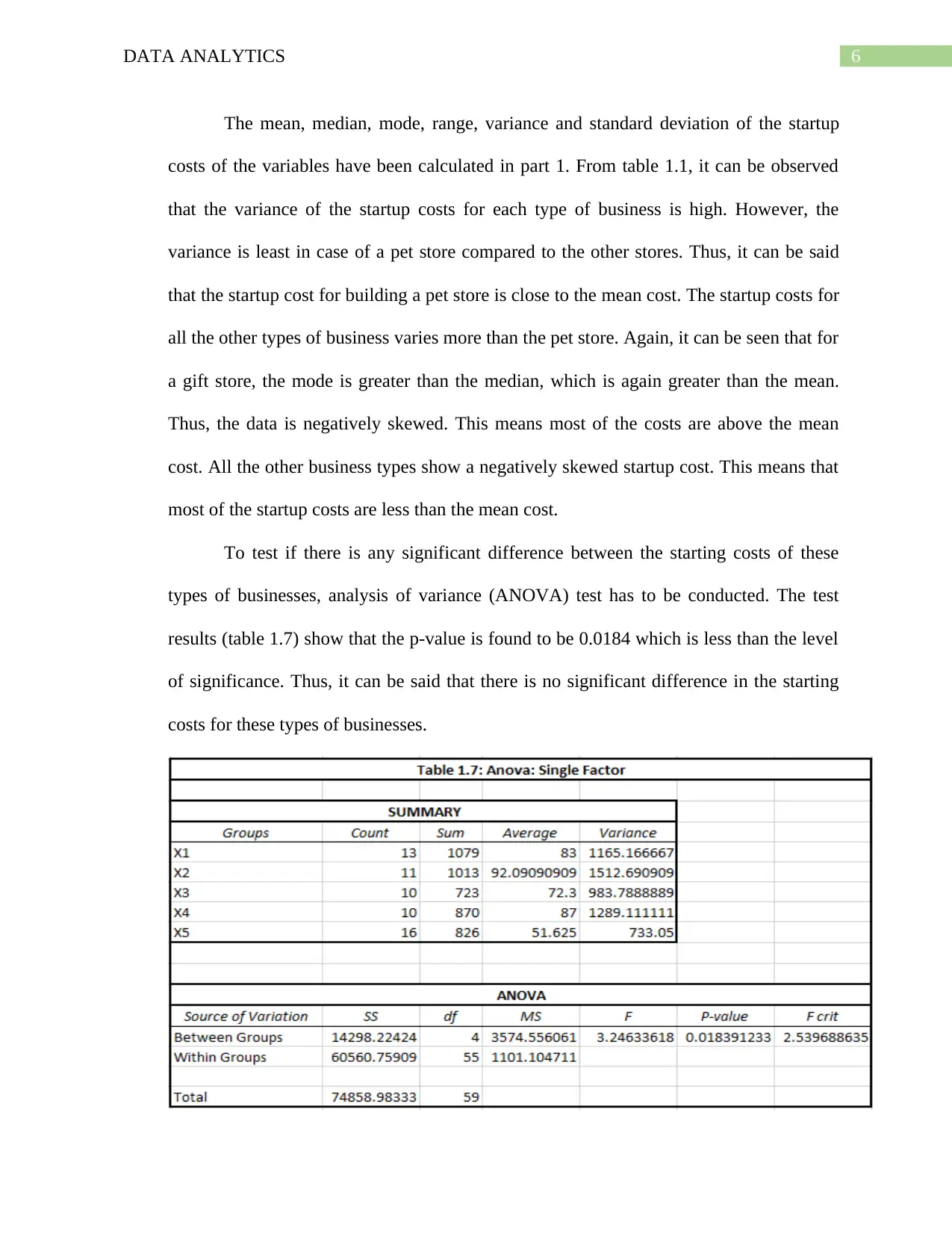
6DATA ANALYTICS
The mean, median, mode, range, variance and standard deviation of the startup
costs of the variables have been calculated in part 1. From table 1.1, it can be observed
that the variance of the startup costs for each type of business is high. However, the
variance is least in case of a pet store compared to the other stores. Thus, it can be said
that the startup cost for building a pet store is close to the mean cost. The startup costs for
all the other types of business varies more than the pet store. Again, it can be seen that for
a gift store, the mode is greater than the median, which is again greater than the mean.
Thus, the data is negatively skewed. This means most of the costs are above the mean
cost. All the other business types show a negatively skewed startup cost. This means that
most of the startup costs are less than the mean cost.
To test if there is any significant difference between the starting costs of these
types of businesses, analysis of variance (ANOVA) test has to be conducted. The test
results (table 1.7) show that the p-value is found to be 0.0184 which is less than the level
of significance. Thus, it can be said that there is no significant difference in the starting
costs for these types of businesses.
The mean, median, mode, range, variance and standard deviation of the startup
costs of the variables have been calculated in part 1. From table 1.1, it can be observed
that the variance of the startup costs for each type of business is high. However, the
variance is least in case of a pet store compared to the other stores. Thus, it can be said
that the startup cost for building a pet store is close to the mean cost. The startup costs for
all the other types of business varies more than the pet store. Again, it can be seen that for
a gift store, the mode is greater than the median, which is again greater than the mean.
Thus, the data is negatively skewed. This means most of the costs are above the mean
cost. All the other business types show a negatively skewed startup cost. This means that
most of the startup costs are less than the mean cost.
To test if there is any significant difference between the starting costs of these
types of businesses, analysis of variance (ANOVA) test has to be conducted. The test
results (table 1.7) show that the p-value is found to be 0.0184 which is less than the level
of significance. Thus, it can be said that there is no significant difference in the starting
costs for these types of businesses.
Paraphrase This Document
Need a fresh take? Get an instant paraphrase of this document with our AI Paraphraser
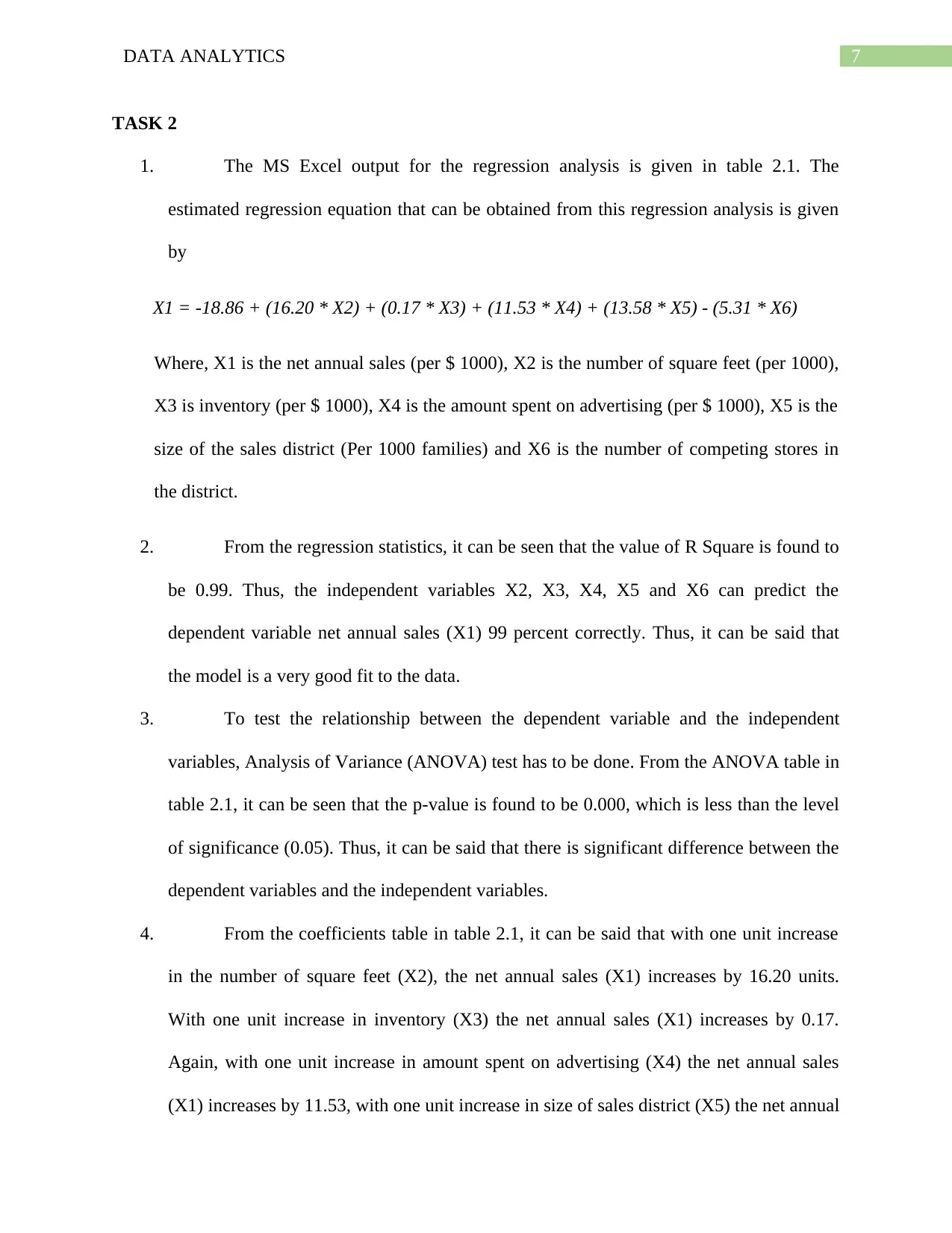
7DATA ANALYTICS
TASK 2
1. The MS Excel output for the regression analysis is given in table 2.1. The
estimated regression equation that can be obtained from this regression analysis is given
by
X1 = -18.86 + (16.20 * X2) + (0.17 * X3) + (11.53 * X4) + (13.58 * X5) - (5.31 * X6)
Where, X1 is the net annual sales (per $ 1000), X2 is the number of square feet (per 1000),
X3 is inventory (per $ 1000), X4 is the amount spent on advertising (per $ 1000), X5 is the
size of the sales district (Per 1000 families) and X6 is the number of competing stores in
the district.
2. From the regression statistics, it can be seen that the value of R Square is found to
be 0.99. Thus, the independent variables X2, X3, X4, X5 and X6 can predict the
dependent variable net annual sales (X1) 99 percent correctly. Thus, it can be said that
the model is a very good fit to the data.
3. To test the relationship between the dependent variable and the independent
variables, Analysis of Variance (ANOVA) test has to be done. From the ANOVA table in
table 2.1, it can be seen that the p-value is found to be 0.000, which is less than the level
of significance (0.05). Thus, it can be said that there is significant difference between the
dependent variables and the independent variables.
4. From the coefficients table in table 2.1, it can be said that with one unit increase
in the number of square feet (X2), the net annual sales (X1) increases by 16.20 units.
With one unit increase in inventory (X3) the net annual sales (X1) increases by 0.17.
Again, with one unit increase in amount spent on advertising (X4) the net annual sales
(X1) increases by 11.53, with one unit increase in size of sales district (X5) the net annual
TASK 2
1. The MS Excel output for the regression analysis is given in table 2.1. The
estimated regression equation that can be obtained from this regression analysis is given
by
X1 = -18.86 + (16.20 * X2) + (0.17 * X3) + (11.53 * X4) + (13.58 * X5) - (5.31 * X6)
Where, X1 is the net annual sales (per $ 1000), X2 is the number of square feet (per 1000),
X3 is inventory (per $ 1000), X4 is the amount spent on advertising (per $ 1000), X5 is the
size of the sales district (Per 1000 families) and X6 is the number of competing stores in
the district.
2. From the regression statistics, it can be seen that the value of R Square is found to
be 0.99. Thus, the independent variables X2, X3, X4, X5 and X6 can predict the
dependent variable net annual sales (X1) 99 percent correctly. Thus, it can be said that
the model is a very good fit to the data.
3. To test the relationship between the dependent variable and the independent
variables, Analysis of Variance (ANOVA) test has to be done. From the ANOVA table in
table 2.1, it can be seen that the p-value is found to be 0.000, which is less than the level
of significance (0.05). Thus, it can be said that there is significant difference between the
dependent variables and the independent variables.
4. From the coefficients table in table 2.1, it can be said that with one unit increase
in the number of square feet (X2), the net annual sales (X1) increases by 16.20 units.
With one unit increase in inventory (X3) the net annual sales (X1) increases by 0.17.
Again, with one unit increase in amount spent on advertising (X4) the net annual sales
(X1) increases by 11.53, with one unit increase in size of sales district (X5) the net annual
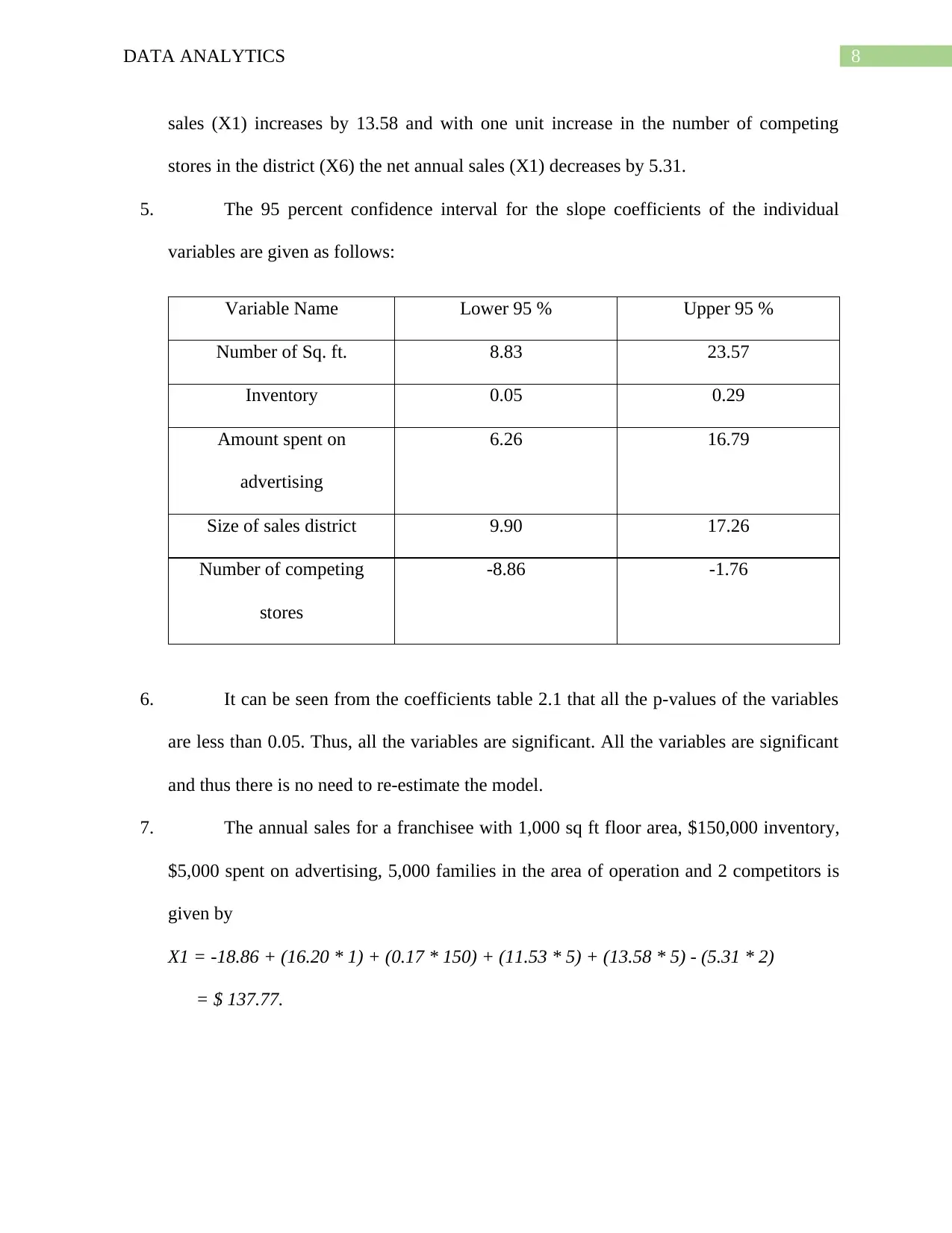
8DATA ANALYTICS
sales (X1) increases by 13.58 and with one unit increase in the number of competing
stores in the district (X6) the net annual sales (X1) decreases by 5.31.
5. The 95 percent confidence interval for the slope coefficients of the individual
variables are given as follows:
Variable Name Lower 95 % Upper 95 %
Number of Sq. ft. 8.83 23.57
Inventory 0.05 0.29
Amount spent on
advertising
6.26 16.79
Size of sales district 9.90 17.26
Number of competing
stores
-8.86 -1.76
6. It can be seen from the coefficients table 2.1 that all the p-values of the variables
are less than 0.05. Thus, all the variables are significant. All the variables are significant
and thus there is no need to re-estimate the model.
7. The annual sales for a franchisee with 1,000 sq ft floor area, $150,000 inventory,
$5,000 spent on advertising, 5,000 families in the area of operation and 2 competitors is
given by
X1 = -18.86 + (16.20 * 1) + (0.17 * 150) + (11.53 * 5) + (13.58 * 5) - (5.31 * 2)
= $ 137.77.
sales (X1) increases by 13.58 and with one unit increase in the number of competing
stores in the district (X6) the net annual sales (X1) decreases by 5.31.
5. The 95 percent confidence interval for the slope coefficients of the individual
variables are given as follows:
Variable Name Lower 95 % Upper 95 %
Number of Sq. ft. 8.83 23.57
Inventory 0.05 0.29
Amount spent on
advertising
6.26 16.79
Size of sales district 9.90 17.26
Number of competing
stores
-8.86 -1.76
6. It can be seen from the coefficients table 2.1 that all the p-values of the variables
are less than 0.05. Thus, all the variables are significant. All the variables are significant
and thus there is no need to re-estimate the model.
7. The annual sales for a franchisee with 1,000 sq ft floor area, $150,000 inventory,
$5,000 spent on advertising, 5,000 families in the area of operation and 2 competitors is
given by
X1 = -18.86 + (16.20 * 1) + (0.17 * 150) + (11.53 * 5) + (13.58 * 5) - (5.31 * 2)
= $ 137.77.
⊘ This is a preview!⊘
Do you want full access?
Subscribe today to unlock all pages.

Trusted by 1+ million students worldwide
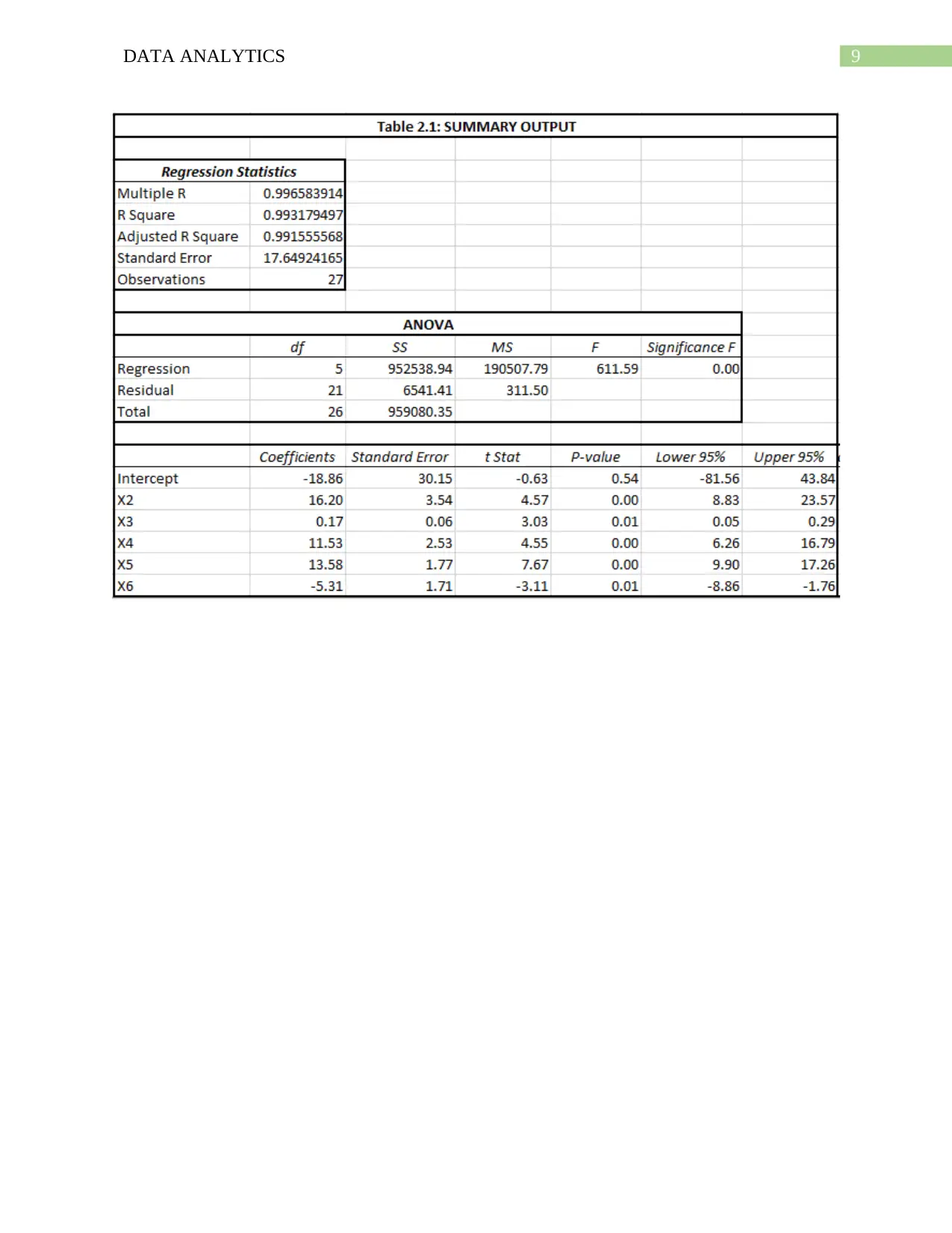
9DATA ANALYTICS
Paraphrase This Document
Need a fresh take? Get an instant paraphrase of this document with our AI Paraphraser
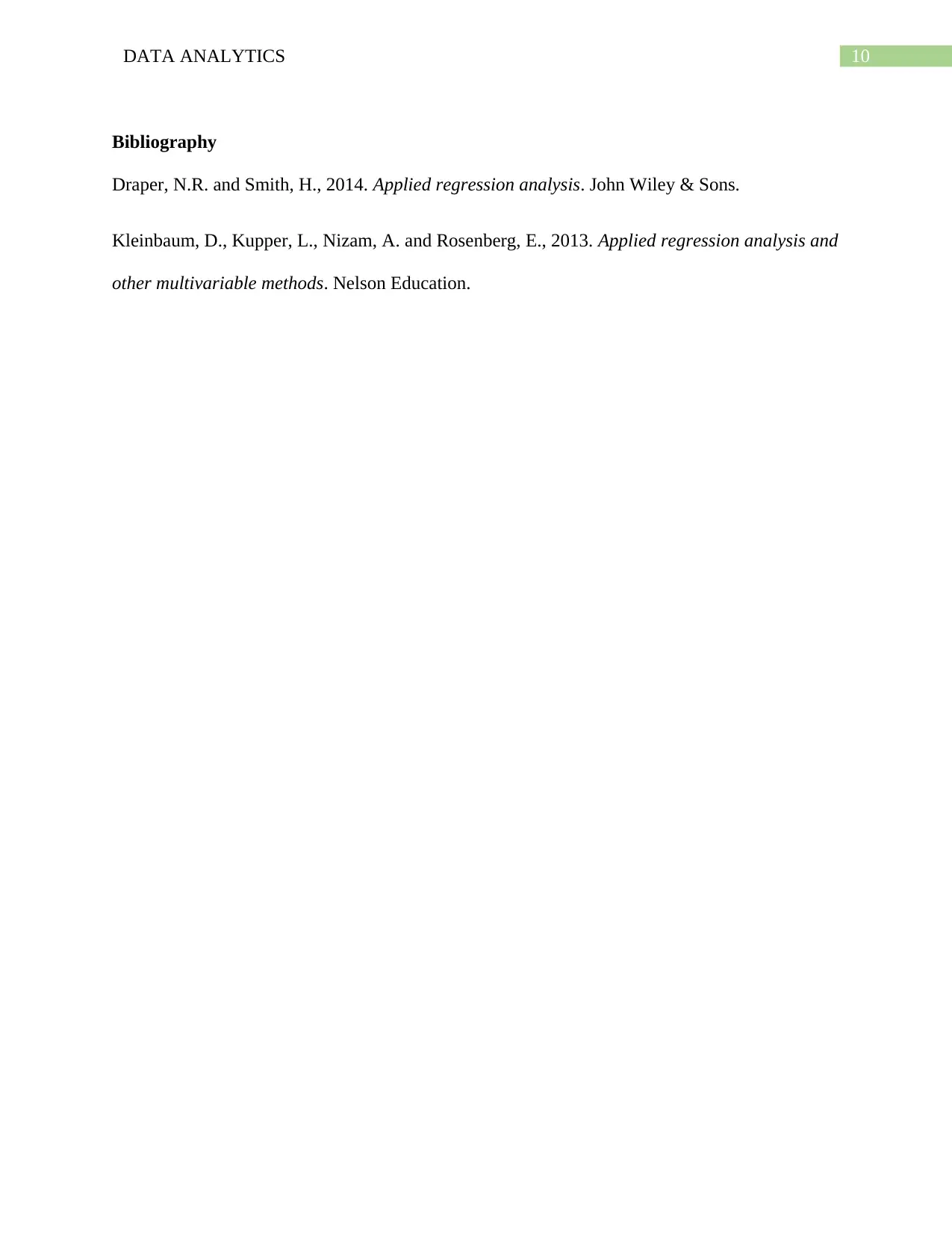
10DATA ANALYTICS
Bibliography
Draper, N.R. and Smith, H., 2014. Applied regression analysis. John Wiley & Sons.
Kleinbaum, D., Kupper, L., Nizam, A. and Rosenberg, E., 2013. Applied regression analysis and
other multivariable methods. Nelson Education.
Bibliography
Draper, N.R. and Smith, H., 2014. Applied regression analysis. John Wiley & Sons.
Kleinbaum, D., Kupper, L., Nizam, A. and Rosenberg, E., 2013. Applied regression analysis and
other multivariable methods. Nelson Education.
1 out of 11
Related Documents
Your All-in-One AI-Powered Toolkit for Academic Success.
+13062052269
info@desklib.com
Available 24*7 on WhatsApp / Email
![[object Object]](/_next/static/media/star-bottom.7253800d.svg)
Unlock your academic potential
Copyright © 2020–2025 A2Z Services. All Rights Reserved. Developed and managed by ZUCOL.





